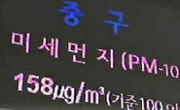먼지발생 모델링은 지표면 근처의 바람의 세기가 임계값을 넘어설 때 먼지가 발생한다고 가정하며, 이 임계값은 흔히 임계마찰속도로 표현된다. 따라서, 황사발생량을 정확히 예측하기 위...
http://chineseinput.net/에서 pinyin(병음)방식으로 중국어를 변환할 수 있습니다.
변환된 중국어를 복사하여 사용하시면 됩니다.
- 中文 을 입력하시려면 zhongwen을 입력하시고 space를누르시면됩니다.
- 北京 을 입력하시려면 beijing을 입력하시고 space를 누르시면 됩니다.

황사발생량 예측을 위한 임계마찰속도 산정 방법 개선 = Improvement of the Method of Determination of Threshold Friction Velocity for Wind-blown Dust Emission Estimation
한글로보기https://www.riss.kr/link?id=A103238667
- 저자
- 발행기관
- 학술지명
- 권호사항
-
발행연도
2011
-
작성언어
Korean
- 주제어
-
등재정보
KCI등재후보
-
자료형태
학술저널
-
수록면
239-247(9쪽)
-
KCI 피인용횟수
0
- 제공처
-
0
상세조회 -
0
다운로드
부가정보
국문 초록 (Abstract)
먼지발생 모델링은 지표면 근처의 바람의 세기가 임계값을 넘어설 때 먼지가 발생한다고 가정하며, 이 임계값은 흔히 임계마찰속도로 표현된다. 따라서, 황사발생량을 정확히 예측하기 위해서는 임계마찰속도를 정확하게 예측하는 것이 무엇보다도 중요하다. 임계마찰속도는 바람에 의한 먼지 발생을 억제하는 정도를 나타내는 값으로서 토질, 토지피복, 수분함유량과 같은 토양 특성에 따라 달라진다. 황사의 발생과 수송을 모의하는 대기질 모델은 수십 km 크기의 수평 격자들로 이루어지며, 이럴 때 한 지표면 격자에는 여러 가지 토지피복이 혼합돼 있는 것이 일반적이기 때문에, 보통 각토지피복이 차지하는 넓이를 가중인자로 하는 기하평균을 각 격자의 대표 거칠기 길이로 사용하여 마찰속도를 결정하게 된다. 그러나, 본 연구에서 살펴본 바에 따르면, 이렇게 평균 거칠기 길이를 사용하여 모의할 경우, 맨땅이 주요 토지피복이 아닌 격자에 대해서는 지표면 거칠기 길이와 임계마찰속도가 지나치게 크게 계산됨으로써 그 격자 전체에서의 먼지 발생이 불가능한 것으로 나타나는 오류가 있다. 이러한 문제를 해결하기 위해서 본 연구에서는 격자 크기를 무한히 작게 가져가는 이상적인 경우를 살펴보고, 이를 대형 격자 구조에서 구현하는 방법으로 한 격자의 대표 거칠기 길이를 전체 토지피복 범주에 대한 평균이 아닌 맨땅에 대한 거칠기 길이로 정하되 먼지 발생 면적을 그 격자에서 맨땅이 차지하는 분율로 제한하는 방식을 제안하였다. 개선된 알고리즘에 따라 2006년 4월에 발생했던 황사 기간에 대해 평균 지표면 거칠기 길이와 임계마찰속도의 분포를 모의하였다. 임계마찰속도를 구하는 데 필요한 토양 수분함유량을 추정하기 위해 기상 모델 MM5를 사용하였다. 얻어진 평균 지표면 거칠기 길이와 임계마찰속도의 분포는 합리적인 결과를 보였으며, 특히 모의된 임계마찰속도는 관측결과를 통계적으로 분석한 선행 연구의 결과와 비교적 잘 일치하였다.
다국어 초록 (Multilingual Abstract)
Wind-blown dust is emitted when near-surface wind speed exceeds a threshold value, which is often expressed as the threshold friction velocity. Therefore, it is important to estimate the threshold friction velocity accurately for reliable wind-blown d...
Wind-blown dust is emitted when near-surface wind speed exceeds a threshold value, which is often expressed as the threshold friction velocity. Therefore, it is important to estimate the threshold friction velocity accurately for reliable wind-blown dust emission forecast. Threshold friction velocity represents the erodibility of the surface soil and depends on surface characteristics such as land-cover, soil texture, and soil moisture content. Typical air quality models in which a wind-blown dust emission module is incorporated use horizontal grid size of tens of kilometers and each grid consists of several different land-cover categories. Thus, the representative surface roughness length is generally determined as the geometric mean of those land-cover categories for computing the threshold friction velocity. According to the assessment of this study, however, the average surface roughness length leads to too high threshold friction velocity for the entire grid and unreasonably disable the dust emission from barren land portion of the grid. By comparing with an ideal case in which the grid size is infinitesimal, we suggest that the representative surface roughness length should be determined not by average of all land-cover categories but by barren land only and the fraction of barren land should be multiplied when the dust emission amount is calculated in a large grid system. The improved algorithm was applied to modelling of surface roughness length and threshold friction velocity over the wind-blown dust emission areas for an Asian dust storm event that occurred in April 2006. The meteorological model MM5 was used to estimate the soil moisture content required to calculate the threshold friction velocity. The model-estimated surface roughness length and threshold friction velocity were reasonable. In particular, the modelled threshold friction velocity was in good agreement with a previous study that analyzed the observations statistically.
참고문헌 (Reference)
1 강광규, "동북아지역의 황사 피해 분석 및 피해저감을 위한 지역 협력방안 II" 한국환경정책평가연구원 2004
2 In, H.-J., "simulation of long-range transport of Yellow Sand observed in April 1998 in Korea" 36 : 4173-4187, 2002
3 Helgren, D.M., "Wind velocities associated with dust deflation events in the western Sahara" 26 : 1147-1151, 1987
4 Mahowald, N. M., "Understanding the 30year Barbados desert dust record" 107 : 4561-, 2002
5 Priesley, C. H. B., "Turbulent Transfer in the Lower Atmosphere" University of Chicago Press 1959
6 Jaffe, D. A., "Transport of Asian air pollution to North America. Geophys" 26 : 711-714, 1999
7 Gillette, D.A., "Threshold velocities for input of soil particles into the air by desert soils" 85 : 5621-5630, 1980
8 Levin, Z., "The effects of desert particles coated with sulfate on rain formation in the eastern Mediterranean" 35 : 1511-1523, 1511
9 Ginoux, P., "Sources and distributions of dust aerosols simulated with the GOCART model" 106 : 20255-20274, 2001
10 Park, S. H., "Simulation of entrainment and transport of dust particles within North America in April 2001 ("Red Dust Episode")" 112 : D20209-, 2007
1 강광규, "동북아지역의 황사 피해 분석 및 피해저감을 위한 지역 협력방안 II" 한국환경정책평가연구원 2004
2 In, H.-J., "simulation of long-range transport of Yellow Sand observed in April 1998 in Korea" 36 : 4173-4187, 2002
3 Helgren, D.M., "Wind velocities associated with dust deflation events in the western Sahara" 26 : 1147-1151, 1987
4 Mahowald, N. M., "Understanding the 30year Barbados desert dust record" 107 : 4561-, 2002
5 Priesley, C. H. B., "Turbulent Transfer in the Lower Atmosphere" University of Chicago Press 1959
6 Jaffe, D. A., "Transport of Asian air pollution to North America. Geophys" 26 : 711-714, 1999
7 Gillette, D.A., "Threshold velocities for input of soil particles into the air by desert soils" 85 : 5621-5630, 1980
8 Levin, Z., "The effects of desert particles coated with sulfate on rain formation in the eastern Mediterranean" 35 : 1511-1523, 1511
9 Ginoux, P., "Sources and distributions of dust aerosols simulated with the GOCART model" 106 : 20255-20274, 2001
10 Park, S. H., "Simulation of entrainment and transport of dust particles within North America in April 2001 ("Red Dust Episode")" 112 : D20209-, 2007
11 Park, S. H., "Sensitivity of surface characteristics on the simulation of wind-blown dust source in North America" Atmospheric Environment in press 2009
12 Park, S. H., "Relative impact of windblown dust versus anthropogenic fugitive dust in PM2.5 on air quality in North America" 115 : D16210-, 2010
13 Kalma, J. D., "Potential wind erosion in Australia: A continental perspective" 8 : 411-428, 1988
14 Fecan, F., "Parameterization of the increase of the aeolian erosion threshold wind friction velocity due to soil moisture for arid and semi-arid areas" 17 : 149-157, 1999
15 Park, S. U., "Parameterization of dust emission for the simulation of the yellow sand (Asian dust) event observed in March 2002 in Korea" 108 (108): 4618-, 2003
16 이은희, "Parameterization of Asian dust (Hwangsa) particle-size distributions for use in dust emission models" PERGAMON-ELSEVIER SCIENCE LTD 38 (38): 2155-2162, 200405
17 홍성유, "Nonlocal boundary layer vertical diffusion in a Medium-Range Forecast Model" 124 (124): 2322-2339, 199610
18 Marticorena, B., "Modeling the atmospheric dust cycle. Part 1: Design of a soil-derived dust emission scheme" 100 : 16415-16430, 1995
19 Tegen, I., "Modeling of mineral dust in the atmosphere: Sources, transport, and optical thickness" 99 : 22897-22914, 1994
20 Zender, C. S., "Mineral Dust Entrainment and Deposition (DEAD) model: Description and 1990s dust climatology" 108 : 4416-, 2003
21 Chun, Y.-S., "Long-range transport of Yellow Sand with special emphasis on the dust rise conditions in the source regions" Seoul National University 1996
22 Park, S.-U., "Field survey of Yellow Sand source regions" 2002
23 In, H.-J., "Estimation of dust emission amount for a dust stormevent occurred in April 1998 in China" 148 : 201-221, 2003
24 Haywood, J., "Estimates of the direct and indirect radiative forcing due to tropospheric aerosols" 38 : 513-543, 2000
25 Fryberger, S. G., "Dune forms and wind regime. In "A Study of Global Sand Seas" 137-170, 1979
26 Sokolik, I. N., "Direct radiative forcing by anthropogenic airborne mineral aerosols" 381 : 681-683, 1996
27 Xiu, A., "Development of a land surface model. Part I: Application in a mesoscale meteorology model" 40 : 192-209, 2001
28 박성훈, "Development of a New Wind-Blown-Dust Emission Module Using Comparative Assessment of Existing Dust Models" Taylor & Francis 28 : 267-286, 201006
29 Taylor, P., "Comments and further analysis on the effective roughness length for use in numerical three dimensional models" 39 : 403-419, 1987
30 Gong, S. L., "Characterization of soil dust distributions in China and its transport during ACE-ASIA: 2. Model simulation and validation" 108 : 4262-, 2003
31 김현미, "Application of adjoint-based forecast sensitivities to Asian dust transport events in Korea" 195 : 335-343, 200811
32 Zhao, T. L., "An assessment of dust emission schemes in modeling east Asian dust storms" 111 : D05S90-, 2006
33 Bai, N., "About Sandstorms in China, 2000. 2001" 2001
34 Shao, Y., "A simple expression for wind erosion threshold friction velocity" 105 : 22437-22443, 2000
35 Liu, M., "A high-resolution numerical study of the Asian dust storms of April 2001" 108 : 2001
36 Westphal, D.L., "A case study of mobilization and transport of Saharan dust" 45 (45): 2145-2175, 1988
37 Zhao, T. L., "A Simulated Climatology of Asian Dust Aerosol and its Trans- Pacific Transport 1. Mean climate and validation" 19 : 88-103, 2006
동일학술지(권/호) 다른 논문
-
알칼리 및 오존 병합 전처리를 이용한 슬러지 감량화 공정의 실증플랜트 연구
- 한국환경기술학회
- 김홍석 ( Hong-suck Kim )
- 2011
- KCI등재후보
-
- 한국환경기술학회
- 김영호 ( Rong-hu Jin )
- 2011
- KCI등재후보
-
- 한국환경기술학회
- 정도준 ( Do-joon Jung )
- 2011
- KCI등재후보
-
- 한국환경기술학회
- 김민환 ( Min-hwan Kim )
- 2011
- KCI등재후보
분석정보
인용정보 인용지수 설명보기
학술지 이력
| 연월일 | 이력구분 | 이력상세 | 등재구분 |
|---|---|---|---|
| 2022 | 평가예정 | 재인증평가 신청대상 (재인증) | |
| 2019-01-01 | 평가 | 등재학술지 선정 (계속평가) |  |
| 2018-12-01 | 평가 | 등재후보로 하락 (계속평가) |  |
| 2017-12-21 | 학회명변경 | 영문명 : The Society For Environmental Technology In Korea -> Korean Society for Environmental Technology |  |
| 2017-10-19 | 학술지명변경 | 외국어명 : Journal of Korean Society Environmental Technology -> Journal of the Korean Society for Environmental Technology |  |
| 2015-01-01 | 평가 | 등재학술지 선정 (계속평가) |  |
| 2013-07-24 | 학술지명변경 | 한글명 : 한국환경기술학회 -> 한국환경기술학회지 |  |
| 2013-01-01 | 평가 | 등재후보 1차 FAIL (등재후보1차) |  |
| 2012-01-01 | 평가 | 등재후보학술지 유지 (기타) |  |
| 2010-01-01 | 평가 | 등재후보학술지 선정 (신규평가) |  |
학술지 인용정보
| 기준연도 | WOS-KCI 통합IF(2년) | KCIF(2년) | KCIF(3년) |
|---|---|---|---|
| 2016 | 0.2 | 0.2 | 0.19 |
| KCIF(4년) | KCIF(5년) | 중심성지수(3년) | 즉시성지수 |
| 0.18 | 0.17 | 0.246 | 0.06 |




 KISS
KISS





